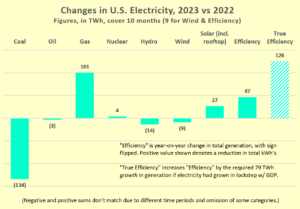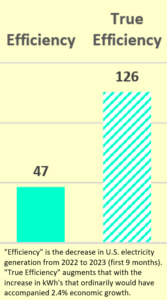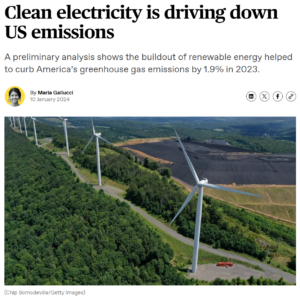The talented data analysts at Rhodium Corp. reported this week that U.S. emissions of greenhouse gases fell nearly two percent last year, even as national economic output rose by 2.4%. This was good news, further evidence of “decoupling” emissions from economic activity. But it was also bad news because, says Rhodium, the 1.9% drop in GHG’s was woefully short of the 6.9% annual decrease required from now to 2030 to meet our Paris target of a 50-52% reduction in GHG emissions below 2005 levels.
 Here we examine the locus of the good news: the 8% drop in electricity generation in 2023 vs. 2022 that enabled the 2% drop in overall emissions despite rises in emissions from transportation and some other sectors.
Here we examine the locus of the good news: the 8% drop in electricity generation in 2023 vs. 2022 that enabled the 2% drop in overall emissions despite rises in emissions from transportation and some other sectors.
(Note: Rhodium’s report couches emissions as GHG’s, whereas we calculate and speak in terms of CO2; a request to Rhodium to express their data as CO2 wasn’t answered.)
The chart at left seems to reinforce the customary line that the leading driver of reduced U.S. carbon emissions is the switch to gas-fired power generation from coal-fired electricity. Indeed, the 101 TWh increase in gas-fired kilowatt-hours accounted numerically for three-quarters of the 134 TWh drop in coal, indicating the close (if inverse) link between the two. Since modern “combined cycle” gas-burning plants emit a whopping 60% less CO2 per kWh than coal-burners, substituting the one for the other is a climate win, even allowing for the greenhouse impacts of methane released in gas drilling and transmission.
What’s missing from this narrative is the role of energy efficiency in suppressing demand for electricity, which we depict in the graph’s two right-most bars and in the callout graph below, at right.
The first bar, showing a gain of 47 TWh labeled as Efficiency, denotes the reduction in total U.S. electricity generation over the first 9 months of 2023 vs. the year-earlier 9-month total. That contraction enabled U.S. grids to cut back on fossil-fuel generation. Without it, either the reduction in coal-fired electricity would have been less than the 134 TWh shown, or the increase in gas-fired electricity would have had to be greater than the actual 101 TWh, or a combination of the two. (The other sources — nuclear, hydro, wind and solar — already produce at their maximum capability.) Power-sector emissions would have been greater in either case.
 But the efficiency story doesn’t end there. U.S. economic output wasn’t flat in 2023, it grew by 2.4% over 2022 (per preliminary figures reported by Rhodium). In earlier periods of U.S. history, that economic growth would have required greater electricity production. For most of the last century, the ratio averaged around 2-to-1, i.e., use of electricity grew twice as fast as GDP. From 1975 to around 2005, the relationship was around 1-to-1. Since 2005, in a profound development that few predicted (and which few have acknowledged, other than CTC), U.S. electricity usage has been virtually flat, even as economic activity has risen by more than 40 percent.
But the efficiency story doesn’t end there. U.S. economic output wasn’t flat in 2023, it grew by 2.4% over 2022 (per preliminary figures reported by Rhodium). In earlier periods of U.S. history, that economic growth would have required greater electricity production. For most of the last century, the ratio averaged around 2-to-1, i.e., use of electricity grew twice as fast as GDP. From 1975 to around 2005, the relationship was around 1-to-1. Since 2005, in a profound development that few predicted (and which few have acknowledged, other than CTC), U.S. electricity usage has been virtually flat, even as economic activity has risen by more than 40 percent.
I’ve used a 1-to-1 relationship for this post, i.e., I’ve assumed that if not for increased energy efficiency, the 2.4% year-on-year growth in U.S. economic activity would have required a 2.4% increase in electricity production. Numerically, nearly 80 additional TWh would have been required (calculated as 2.4% of 2022 9-month U.S. electricity production, including rooftop solar, of 3,283,000 TWh). Adding that amount to the actual decrease in electricity yields the true efficiency figure of 126 TWh shown in the right-most bar.
The biggest enabler of the 2022 drop in U.S. coal-fired electricity generation, then, wasn’t the 101 TWh increase in power production from natural gas, though that played a big part. It certainly wasn’t solar, which grew by nearly 15%, a hefty rise, but by just 27 TWh in absolute terms. Nor was it the U.S. wind sector, which actually contracted in the first nine months of the year (see first chart, above). It was the increase in the efficiency with which electricity supports economic activity, which enabled a 126 TWh drop in electricity use vis-a-vis the historical 1-to-1 relationship between use of electricity and GDP.

Well-meaning misinformation from Canary Media, Jan. 10. See link to story in text.
That’s not the standard spin. Rhodium reports that “coal is playing less and less of a role on the grid, while both natural gas and renewable generators are filling the gap.” True, but it leaves out the vital — I would say central — role played by energy efficiency in constraining U.S. electricity demand so that the increase in gas-burning could be held to 101 TWh.
For sheer distortion it’s hard to top Canary Media’s take, shown at left, that “the buildout of renewable energy helped to curb America’s greenhouse gas emissions by 1.9% in 2023.” While that’s true, the gain in renewable power output was a sideshow to electricity efficiency. Indeed, netting the 27 TWh increase in solar output by the combined 23 TWh decrease in hydro and wind generation leaves next to nothing in the way of net renewables growth.
Remember the adage about victory having a thousand fathers while defeat is an orphan? In climate circles and energy policy, last year’s modest success in reducing emissions has multiple parents: more gas-burning, more solar arrays, more renewables. Yet the true climate guardian n 2023 and prior years — increased efficiency in electricity usage — goes unremarked. This inattention is mirrored in policy. The Inflation Reduction Act subsidizes everything from electric cars and heat pumps to battery storage and manufacture of wind turbines and solar cells. It doesn’t, for the most part, subsidize ways to use energy more efficiently.
That’s not deliberate, it’s inherent in the nature of energy efficiency, savings and conservation: they involve ways of doing more with less, and they come in a million guises. They can’t be subsidized, but they can be rewarded, by taxing carbon emissions.
As we’ve been saying for decades: Taxes on fossil fuels, levied “upstream” at mines, wells and import docks, raise the value of every personal, corporate and collective action to reduce unnecessary use of energy. There’s no way around taxing carbon.

[…] Read More […]